Sales Planning Report: Analyzing Sales Strategies and Planning
VerifiedAdded on 2020/01/07
|21
|7557
|215
Report
AI Summary
This report provides a comprehensive analysis of sales planning and marketing strategies, focusing on Plastic Products Ltd. It begins by explaining how personal selling supports the promotion mix, followed by a comparison of buyer behavior and decision-making processes in consumer and business markets. The report analyzes the role of sales teams within the company's marketing strategy, emphasizing their responsibilities in demand management, customer relationship maintenance, and revenue generation. It then delves into how sales strategies align with corporate objectives, covering sales team development, recruiting, and motivation. The report also examines sales organization, control, and the use of databases in effective sales management. Finally, it includes the development of a sales plan, an investigation of international selling opportunities, and the use of exhibitions or trade fairs. The report highlights the importance of understanding both consumer and business markets, emphasizing the need for tailored approaches to maximize sales effectiveness and achieve corporate goals.

Sales Planning
Paraphrase This Document
Need a fresh take? Get an instant paraphrase of this document with our AI Paraphraser
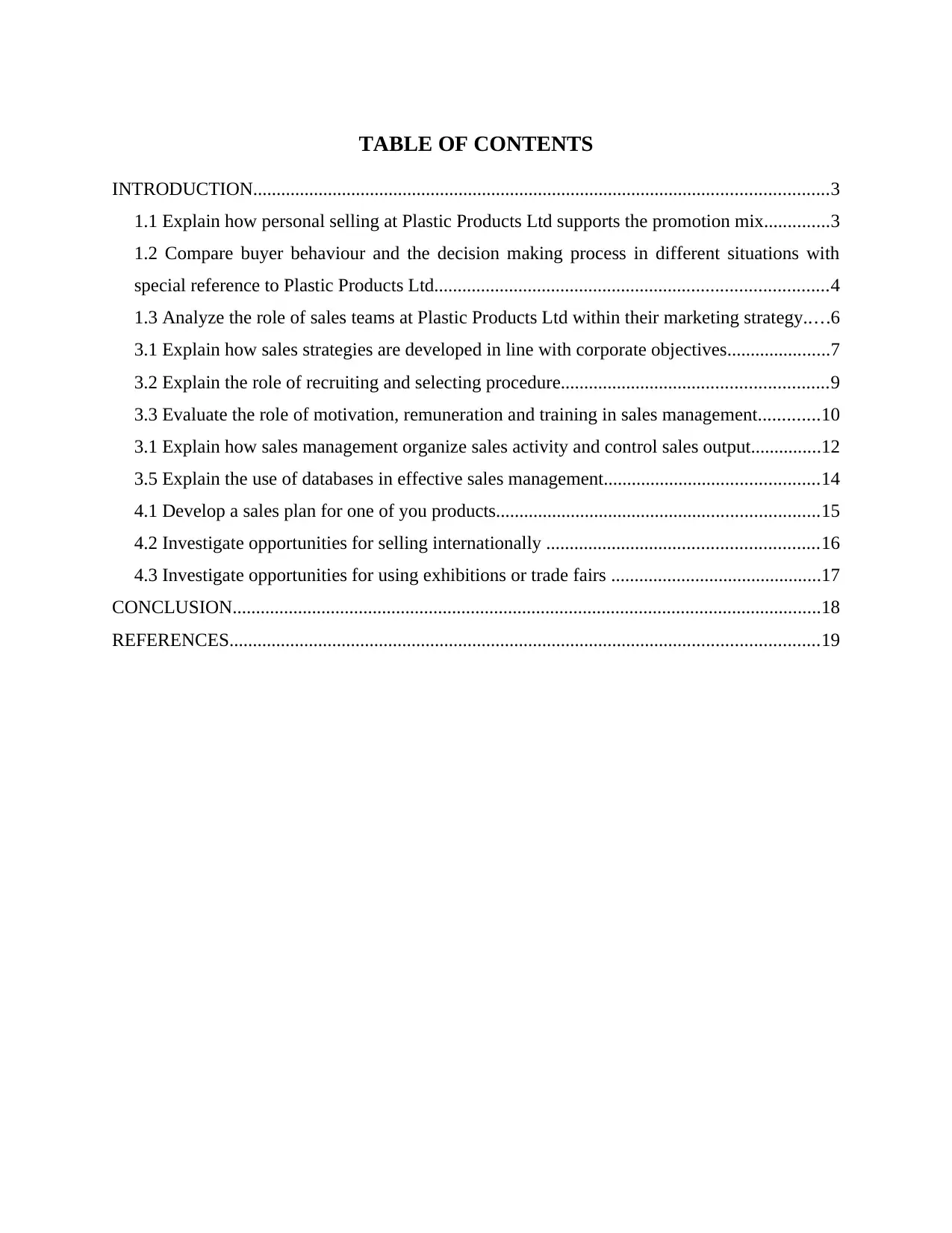
TABLE OF CONTENTS
INTRODUCTION...........................................................................................................................3
1.1 Explain how personal selling at Plastic Products Ltd supports the promotion mix..............3
1.2 Compare buyer behaviour and the decision making process in different situations with
special reference to Plastic Products Ltd....................................................................................4
1.3 Analyze the role of sales teams at Plastic Products Ltd within their marketing strategy.....6
3.1 Explain how sales strategies are developed in line with corporate objectives......................7
3.2 Explain the role of recruiting and selecting procedure.........................................................9
3.3 Evaluate the role of motivation, remuneration and training in sales management.............10
3.1 Explain how sales management organize sales activity and control sales output...............12
3.5 Explain the use of databases in effective sales management..............................................14
4.1 Develop a sales plan for one of you products.....................................................................15
4.2 Investigate opportunities for selling internationally ..........................................................16
4.3 Investigate opportunities for using exhibitions or trade fairs .............................................17
CONCLUSION..............................................................................................................................18
REFERENCES..............................................................................................................................19
INTRODUCTION...........................................................................................................................3
1.1 Explain how personal selling at Plastic Products Ltd supports the promotion mix..............3
1.2 Compare buyer behaviour and the decision making process in different situations with
special reference to Plastic Products Ltd....................................................................................4
1.3 Analyze the role of sales teams at Plastic Products Ltd within their marketing strategy.....6
3.1 Explain how sales strategies are developed in line with corporate objectives......................7
3.2 Explain the role of recruiting and selecting procedure.........................................................9
3.3 Evaluate the role of motivation, remuneration and training in sales management.............10
3.1 Explain how sales management organize sales activity and control sales output...............12
3.5 Explain the use of databases in effective sales management..............................................14
4.1 Develop a sales plan for one of you products.....................................................................15
4.2 Investigate opportunities for selling internationally ..........................................................16
4.3 Investigate opportunities for using exhibitions or trade fairs .............................................17
CONCLUSION..............................................................................................................................18
REFERENCES..............................................................................................................................19
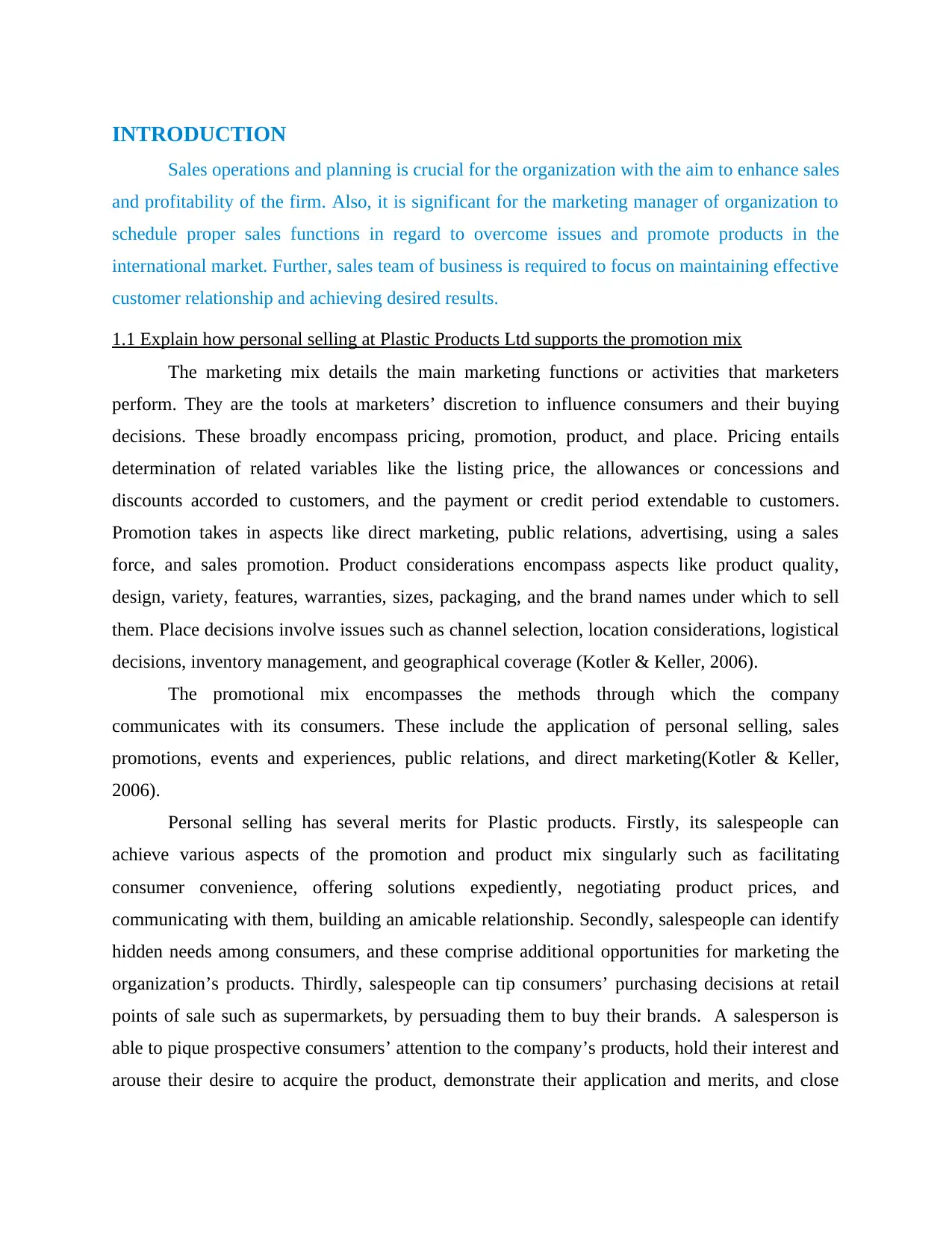
INTRODUCTION
Sales operations and planning is crucial for the organization with the aim to enhance sales
and profitability of the firm. Also, it is significant for the marketing manager of organization to
schedule proper sales functions in regard to overcome issues and promote products in the
international market. Further, sales team of business is required to focus on maintaining effective
customer relationship and achieving desired results.
1.1 Explain how personal selling at Plastic Products Ltd supports the promotion mix
The marketing mix details the main marketing functions or activities that marketers
perform. They are the tools at marketers’ discretion to influence consumers and their buying
decisions. These broadly encompass pricing, promotion, product, and place. Pricing entails
determination of related variables like the listing price, the allowances or concessions and
discounts accorded to customers, and the payment or credit period extendable to customers.
Promotion takes in aspects like direct marketing, public relations, advertising, using a sales
force, and sales promotion. Product considerations encompass aspects like product quality,
design, variety, features, warranties, sizes, packaging, and the brand names under which to sell
them. Place decisions involve issues such as channel selection, location considerations, logistical
decisions, inventory management, and geographical coverage (Kotler & Keller, 2006).
The promotional mix encompasses the methods through which the company
communicates with its consumers. These include the application of personal selling, sales
promotions, events and experiences, public relations, and direct marketing(Kotler & Keller,
2006).
Personal selling has several merits for Plastic products. Firstly, its salespeople can
achieve various aspects of the promotion and product mix singularly such as facilitating
consumer convenience, offering solutions expediently, negotiating product prices, and
communicating with them, building an amicable relationship. Secondly, salespeople can identify
hidden needs among consumers, and these comprise additional opportunities for marketing the
organization’s products. Thirdly, salespeople can tip consumers’ purchasing decisions at retail
points of sale such as supermarkets, by persuading them to buy their brands. A salesperson is
able to pique prospective consumers’ attention to the company’s products, hold their interest and
arouse their desire to acquire the product, demonstrate their application and merits, and close
Sales operations and planning is crucial for the organization with the aim to enhance sales
and profitability of the firm. Also, it is significant for the marketing manager of organization to
schedule proper sales functions in regard to overcome issues and promote products in the
international market. Further, sales team of business is required to focus on maintaining effective
customer relationship and achieving desired results.
1.1 Explain how personal selling at Plastic Products Ltd supports the promotion mix
The marketing mix details the main marketing functions or activities that marketers
perform. They are the tools at marketers’ discretion to influence consumers and their buying
decisions. These broadly encompass pricing, promotion, product, and place. Pricing entails
determination of related variables like the listing price, the allowances or concessions and
discounts accorded to customers, and the payment or credit period extendable to customers.
Promotion takes in aspects like direct marketing, public relations, advertising, using a sales
force, and sales promotion. Product considerations encompass aspects like product quality,
design, variety, features, warranties, sizes, packaging, and the brand names under which to sell
them. Place decisions involve issues such as channel selection, location considerations, logistical
decisions, inventory management, and geographical coverage (Kotler & Keller, 2006).
The promotional mix encompasses the methods through which the company
communicates with its consumers. These include the application of personal selling, sales
promotions, events and experiences, public relations, and direct marketing(Kotler & Keller,
2006).
Personal selling has several merits for Plastic products. Firstly, its salespeople can
achieve various aspects of the promotion and product mix singularly such as facilitating
consumer convenience, offering solutions expediently, negotiating product prices, and
communicating with them, building an amicable relationship. Secondly, salespeople can identify
hidden needs among consumers, and these comprise additional opportunities for marketing the
organization’s products. Thirdly, salespeople can tip consumers’ purchasing decisions at retail
points of sale such as supermarkets, by persuading them to buy their brands. A salesperson is
able to pique prospective consumers’ attention to the company’s products, hold their interest and
arouse their desire to acquire the product, demonstrate their application and merits, and close
⊘ This is a preview!⊘
Do you want full access?
Subscribe today to unlock all pages.

Trusted by 1+ million students worldwide
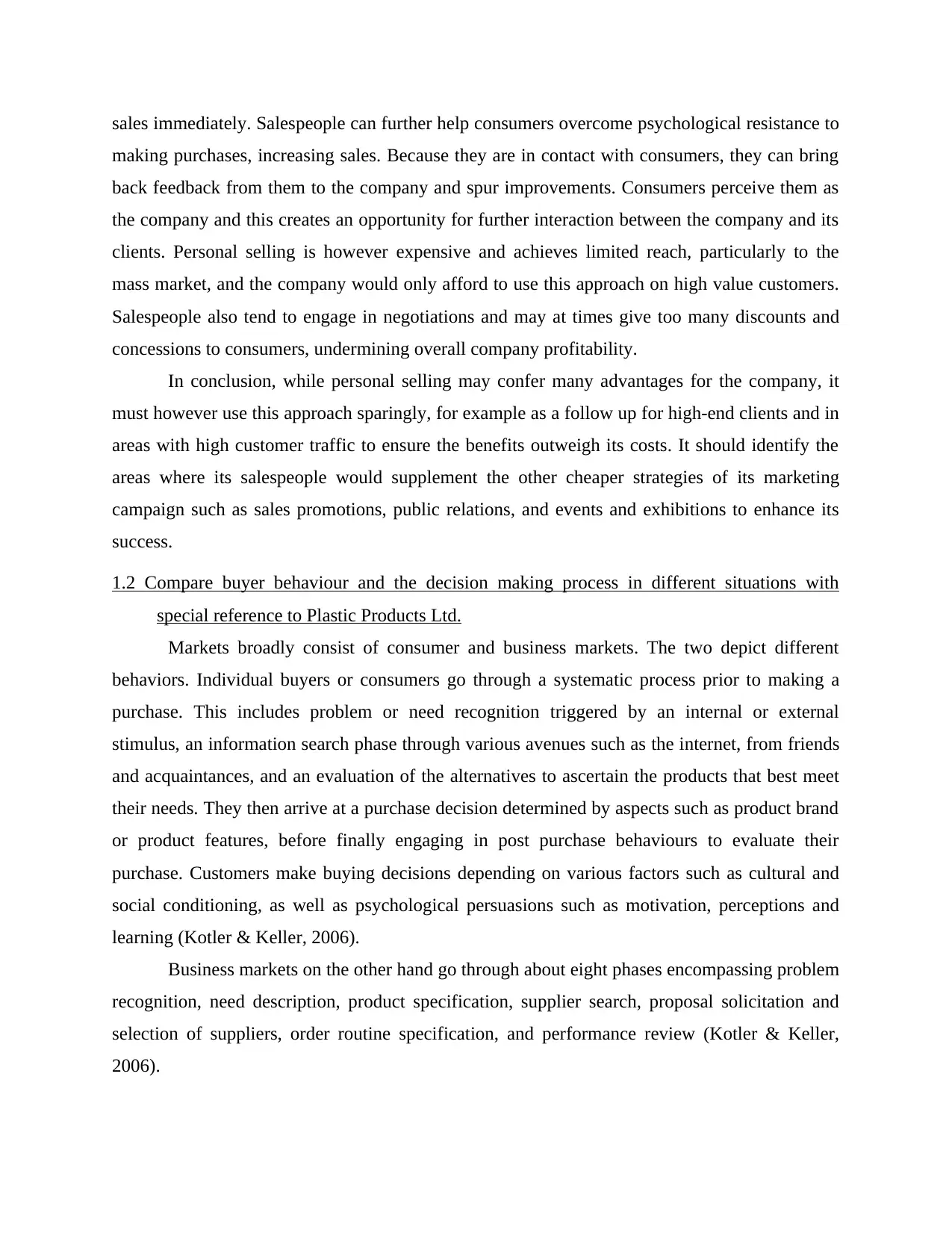
sales immediately. Salespeople can further help consumers overcome psychological resistance to
making purchases, increasing sales. Because they are in contact with consumers, they can bring
back feedback from them to the company and spur improvements. Consumers perceive them as
the company and this creates an opportunity for further interaction between the company and its
clients. Personal selling is however expensive and achieves limited reach, particularly to the
mass market, and the company would only afford to use this approach on high value customers.
Salespeople also tend to engage in negotiations and may at times give too many discounts and
concessions to consumers, undermining overall company profitability.
In conclusion, while personal selling may confer many advantages for the company, it
must however use this approach sparingly, for example as a follow up for high-end clients and in
areas with high customer traffic to ensure the benefits outweigh its costs. It should identify the
areas where its salespeople would supplement the other cheaper strategies of its marketing
campaign such as sales promotions, public relations, and events and exhibitions to enhance its
success.
1.2 Compare buyer behaviour and the decision making process in different situations with
special reference to Plastic Products Ltd.
Markets broadly consist of consumer and business markets. The two depict different
behaviors. Individual buyers or consumers go through a systematic process prior to making a
purchase. This includes problem or need recognition triggered by an internal or external
stimulus, an information search phase through various avenues such as the internet, from friends
and acquaintances, and an evaluation of the alternatives to ascertain the products that best meet
their needs. They then arrive at a purchase decision determined by aspects such as product brand
or product features, before finally engaging in post purchase behaviours to evaluate their
purchase. Customers make buying decisions depending on various factors such as cultural and
social conditioning, as well as psychological persuasions such as motivation, perceptions and
learning (Kotler & Keller, 2006).
Business markets on the other hand go through about eight phases encompassing problem
recognition, need description, product specification, supplier search, proposal solicitation and
selection of suppliers, order routine specification, and performance review (Kotler & Keller,
2006).
making purchases, increasing sales. Because they are in contact with consumers, they can bring
back feedback from them to the company and spur improvements. Consumers perceive them as
the company and this creates an opportunity for further interaction between the company and its
clients. Personal selling is however expensive and achieves limited reach, particularly to the
mass market, and the company would only afford to use this approach on high value customers.
Salespeople also tend to engage in negotiations and may at times give too many discounts and
concessions to consumers, undermining overall company profitability.
In conclusion, while personal selling may confer many advantages for the company, it
must however use this approach sparingly, for example as a follow up for high-end clients and in
areas with high customer traffic to ensure the benefits outweigh its costs. It should identify the
areas where its salespeople would supplement the other cheaper strategies of its marketing
campaign such as sales promotions, public relations, and events and exhibitions to enhance its
success.
1.2 Compare buyer behaviour and the decision making process in different situations with
special reference to Plastic Products Ltd.
Markets broadly consist of consumer and business markets. The two depict different
behaviors. Individual buyers or consumers go through a systematic process prior to making a
purchase. This includes problem or need recognition triggered by an internal or external
stimulus, an information search phase through various avenues such as the internet, from friends
and acquaintances, and an evaluation of the alternatives to ascertain the products that best meet
their needs. They then arrive at a purchase decision determined by aspects such as product brand
or product features, before finally engaging in post purchase behaviours to evaluate their
purchase. Customers make buying decisions depending on various factors such as cultural and
social conditioning, as well as psychological persuasions such as motivation, perceptions and
learning (Kotler & Keller, 2006).
Business markets on the other hand go through about eight phases encompassing problem
recognition, need description, product specification, supplier search, proposal solicitation and
selection of suppliers, order routine specification, and performance review (Kotler & Keller,
2006).
Paraphrase This Document
Need a fresh take? Get an instant paraphrase of this document with our AI Paraphraser
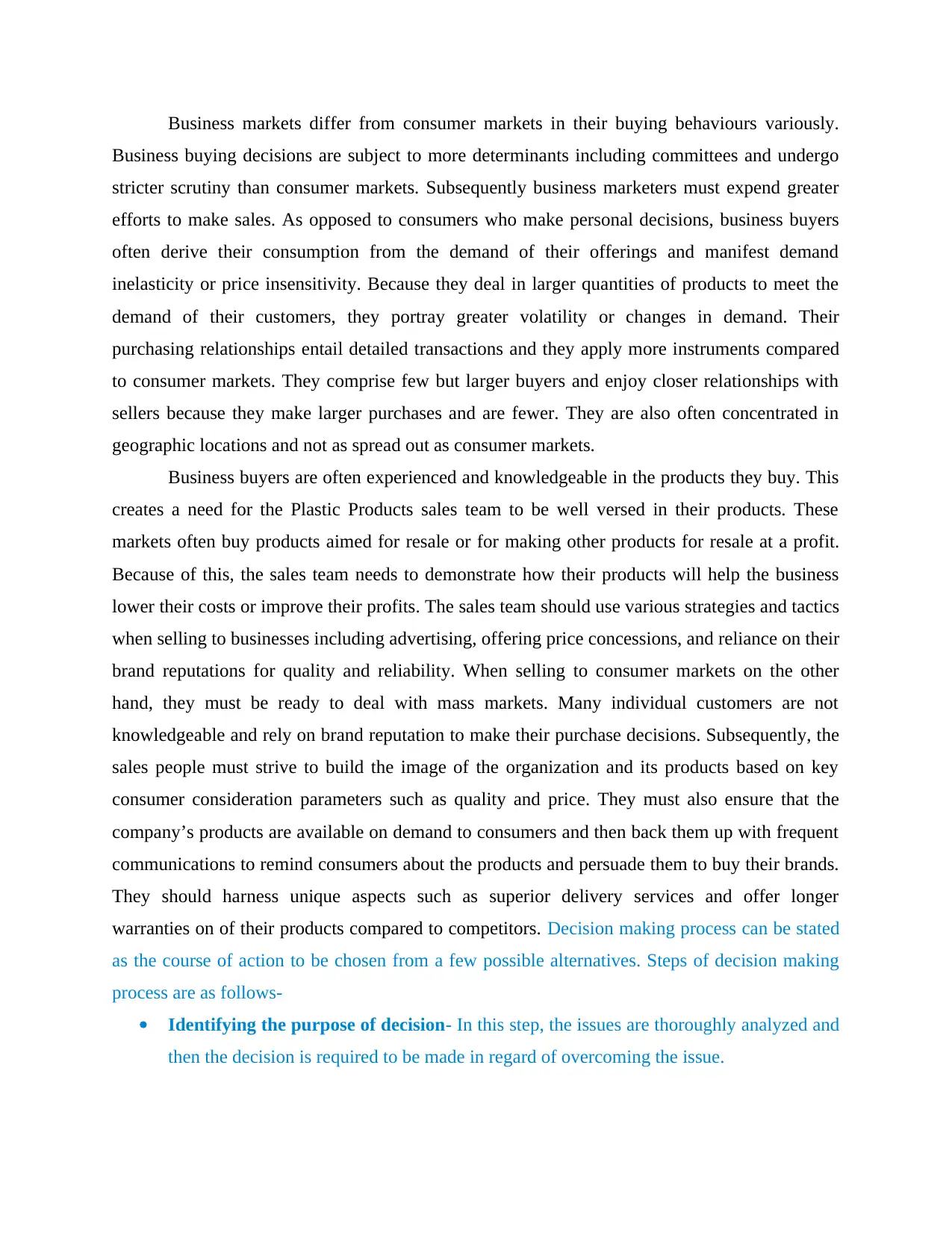
Business markets differ from consumer markets in their buying behaviours variously.
Business buying decisions are subject to more determinants including committees and undergo
stricter scrutiny than consumer markets. Subsequently business marketers must expend greater
efforts to make sales. As opposed to consumers who make personal decisions, business buyers
often derive their consumption from the demand of their offerings and manifest demand
inelasticity or price insensitivity. Because they deal in larger quantities of products to meet the
demand of their customers, they portray greater volatility or changes in demand. Their
purchasing relationships entail detailed transactions and they apply more instruments compared
to consumer markets. They comprise few but larger buyers and enjoy closer relationships with
sellers because they make larger purchases and are fewer. They are also often concentrated in
geographic locations and not as spread out as consumer markets.
Business buyers are often experienced and knowledgeable in the products they buy. This
creates a need for the Plastic Products sales team to be well versed in their products. These
markets often buy products aimed for resale or for making other products for resale at a profit.
Because of this, the sales team needs to demonstrate how their products will help the business
lower their costs or improve their profits. The sales team should use various strategies and tactics
when selling to businesses including advertising, offering price concessions, and reliance on their
brand reputations for quality and reliability. When selling to consumer markets on the other
hand, they must be ready to deal with mass markets. Many individual customers are not
knowledgeable and rely on brand reputation to make their purchase decisions. Subsequently, the
sales people must strive to build the image of the organization and its products based on key
consumer consideration parameters such as quality and price. They must also ensure that the
company’s products are available on demand to consumers and then back them up with frequent
communications to remind consumers about the products and persuade them to buy their brands.
They should harness unique aspects such as superior delivery services and offer longer
warranties on of their products compared to competitors. Decision making process can be stated
as the course of action to be chosen from a few possible alternatives. Steps of decision making
process are as follows-
Identifying the purpose of decision- In this step, the issues are thoroughly analyzed and
then the decision is required to be made in regard of overcoming the issue.
Business buying decisions are subject to more determinants including committees and undergo
stricter scrutiny than consumer markets. Subsequently business marketers must expend greater
efforts to make sales. As opposed to consumers who make personal decisions, business buyers
often derive their consumption from the demand of their offerings and manifest demand
inelasticity or price insensitivity. Because they deal in larger quantities of products to meet the
demand of their customers, they portray greater volatility or changes in demand. Their
purchasing relationships entail detailed transactions and they apply more instruments compared
to consumer markets. They comprise few but larger buyers and enjoy closer relationships with
sellers because they make larger purchases and are fewer. They are also often concentrated in
geographic locations and not as spread out as consumer markets.
Business buyers are often experienced and knowledgeable in the products they buy. This
creates a need for the Plastic Products sales team to be well versed in their products. These
markets often buy products aimed for resale or for making other products for resale at a profit.
Because of this, the sales team needs to demonstrate how their products will help the business
lower their costs or improve their profits. The sales team should use various strategies and tactics
when selling to businesses including advertising, offering price concessions, and reliance on their
brand reputations for quality and reliability. When selling to consumer markets on the other
hand, they must be ready to deal with mass markets. Many individual customers are not
knowledgeable and rely on brand reputation to make their purchase decisions. Subsequently, the
sales people must strive to build the image of the organization and its products based on key
consumer consideration parameters such as quality and price. They must also ensure that the
company’s products are available on demand to consumers and then back them up with frequent
communications to remind consumers about the products and persuade them to buy their brands.
They should harness unique aspects such as superior delivery services and offer longer
warranties on of their products compared to competitors. Decision making process can be stated
as the course of action to be chosen from a few possible alternatives. Steps of decision making
process are as follows-
Identifying the purpose of decision- In this step, the issues are thoroughly analyzed and
then the decision is required to be made in regard of overcoming the issue.
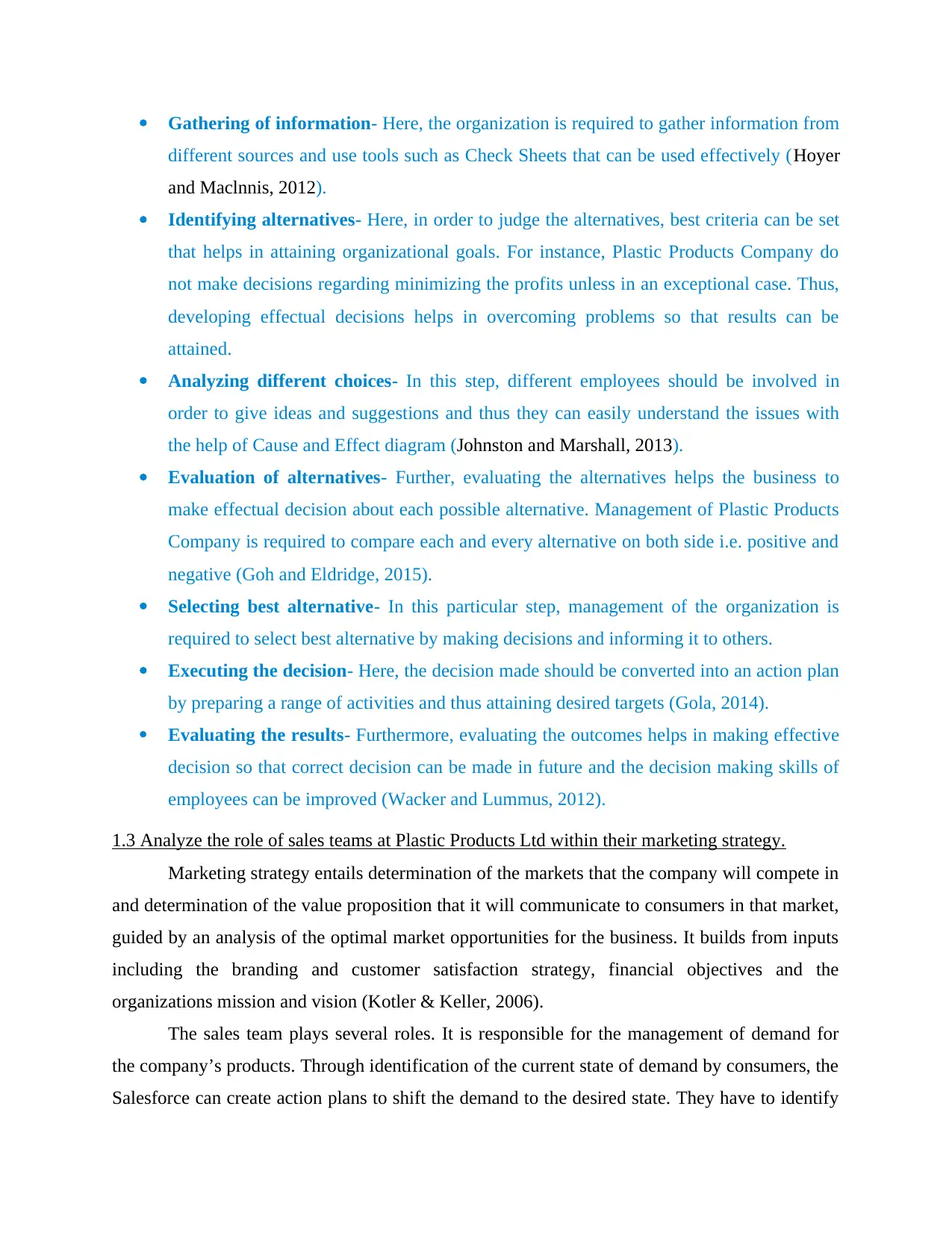
Gathering of information- Here, the organization is required to gather information from
different sources and use tools such as Check Sheets that can be used effectively (Hoyer
and Maclnnis, 2012).
Identifying alternatives- Here, in order to judge the alternatives, best criteria can be set
that helps in attaining organizational goals. For instance, Plastic Products Company do
not make decisions regarding minimizing the profits unless in an exceptional case. Thus,
developing effectual decisions helps in overcoming problems so that results can be
attained.
Analyzing different choices- In this step, different employees should be involved in
order to give ideas and suggestions and thus they can easily understand the issues with
the help of Cause and Effect diagram (Johnston and Marshall, 2013).
Evaluation of alternatives- Further, evaluating the alternatives helps the business to
make effectual decision about each possible alternative. Management of Plastic Products
Company is required to compare each and every alternative on both side i.e. positive and
negative (Goh and Eldridge, 2015).
Selecting best alternative- In this particular step, management of the organization is
required to select best alternative by making decisions and informing it to others.
Executing the decision- Here, the decision made should be converted into an action plan
by preparing a range of activities and thus attaining desired targets (Gola, 2014).
Evaluating the results- Furthermore, evaluating the outcomes helps in making effective
decision so that correct decision can be made in future and the decision making skills of
employees can be improved (Wacker and Lummus, 2012).
1.3 Analyze the role of sales teams at Plastic Products Ltd within their marketing strategy.
Marketing strategy entails determination of the markets that the company will compete in
and determination of the value proposition that it will communicate to consumers in that market,
guided by an analysis of the optimal market opportunities for the business. It builds from inputs
including the branding and customer satisfaction strategy, financial objectives and the
organizations mission and vision (Kotler & Keller, 2006).
The sales team plays several roles. It is responsible for the management of demand for
the company’s products. Through identification of the current state of demand by consumers, the
Salesforce can create action plans to shift the demand to the desired state. They have to identify
different sources and use tools such as Check Sheets that can be used effectively (Hoyer
and Maclnnis, 2012).
Identifying alternatives- Here, in order to judge the alternatives, best criteria can be set
that helps in attaining organizational goals. For instance, Plastic Products Company do
not make decisions regarding minimizing the profits unless in an exceptional case. Thus,
developing effectual decisions helps in overcoming problems so that results can be
attained.
Analyzing different choices- In this step, different employees should be involved in
order to give ideas and suggestions and thus they can easily understand the issues with
the help of Cause and Effect diagram (Johnston and Marshall, 2013).
Evaluation of alternatives- Further, evaluating the alternatives helps the business to
make effectual decision about each possible alternative. Management of Plastic Products
Company is required to compare each and every alternative on both side i.e. positive and
negative (Goh and Eldridge, 2015).
Selecting best alternative- In this particular step, management of the organization is
required to select best alternative by making decisions and informing it to others.
Executing the decision- Here, the decision made should be converted into an action plan
by preparing a range of activities and thus attaining desired targets (Gola, 2014).
Evaluating the results- Furthermore, evaluating the outcomes helps in making effective
decision so that correct decision can be made in future and the decision making skills of
employees can be improved (Wacker and Lummus, 2012).
1.3 Analyze the role of sales teams at Plastic Products Ltd within their marketing strategy.
Marketing strategy entails determination of the markets that the company will compete in
and determination of the value proposition that it will communicate to consumers in that market,
guided by an analysis of the optimal market opportunities for the business. It builds from inputs
including the branding and customer satisfaction strategy, financial objectives and the
organizations mission and vision (Kotler & Keller, 2006).
The sales team plays several roles. It is responsible for the management of demand for
the company’s products. Through identification of the current state of demand by consumers, the
Salesforce can create action plans to shift the demand to the desired state. They have to identify
⊘ This is a preview!⊘
Do you want full access?
Subscribe today to unlock all pages.

Trusted by 1+ million students worldwide
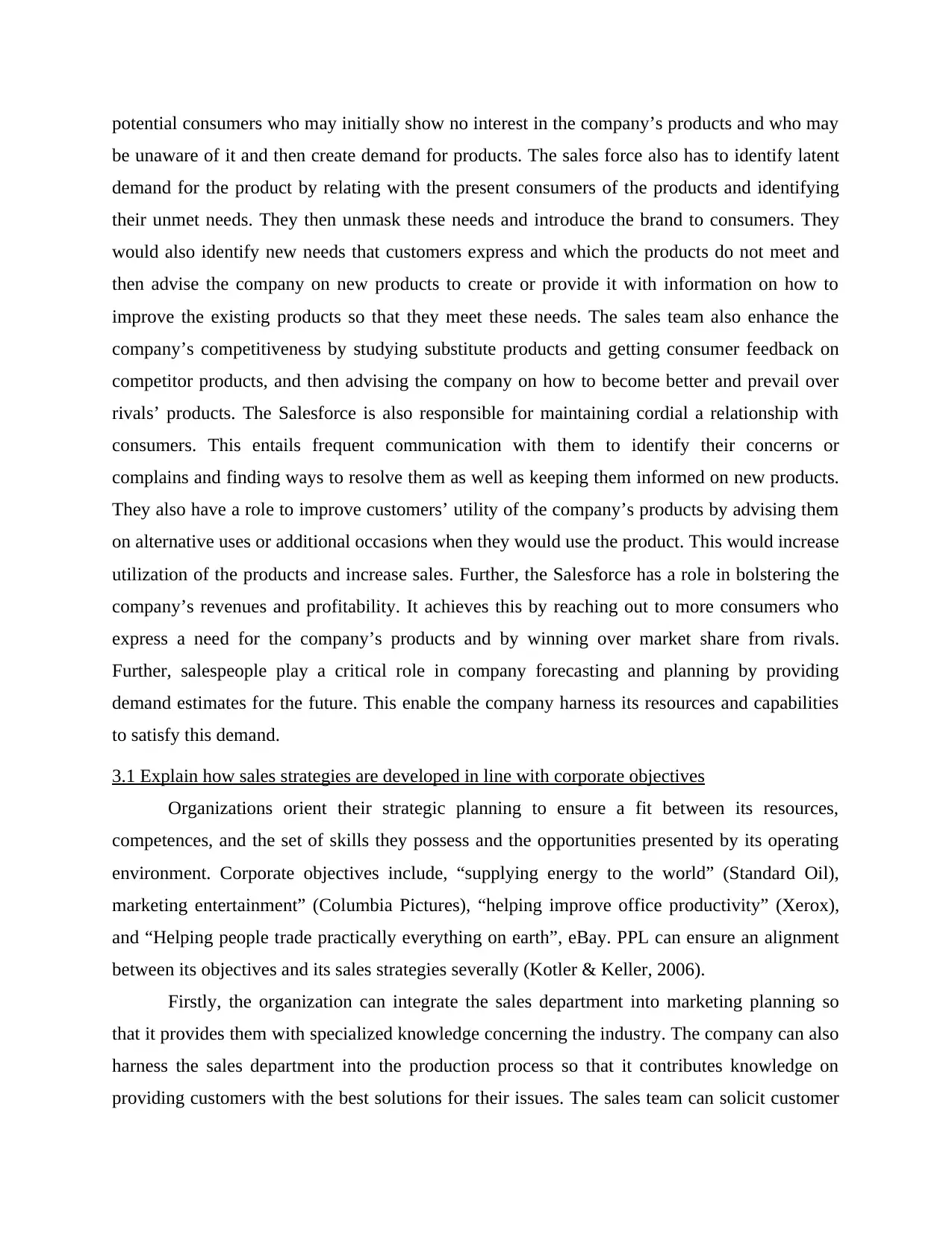
potential consumers who may initially show no interest in the company’s products and who may
be unaware of it and then create demand for products. The sales force also has to identify latent
demand for the product by relating with the present consumers of the products and identifying
their unmet needs. They then unmask these needs and introduce the brand to consumers. They
would also identify new needs that customers express and which the products do not meet and
then advise the company on new products to create or provide it with information on how to
improve the existing products so that they meet these needs. The sales team also enhance the
company’s competitiveness by studying substitute products and getting consumer feedback on
competitor products, and then advising the company on how to become better and prevail over
rivals’ products. The Salesforce is also responsible for maintaining cordial a relationship with
consumers. This entails frequent communication with them to identify their concerns or
complains and finding ways to resolve them as well as keeping them informed on new products.
They also have a role to improve customers’ utility of the company’s products by advising them
on alternative uses or additional occasions when they would use the product. This would increase
utilization of the products and increase sales. Further, the Salesforce has a role in bolstering the
company’s revenues and profitability. It achieves this by reaching out to more consumers who
express a need for the company’s products and by winning over market share from rivals.
Further, salespeople play a critical role in company forecasting and planning by providing
demand estimates for the future. This enable the company harness its resources and capabilities
to satisfy this demand.
3.1 Explain how sales strategies are developed in line with corporate objectives
Organizations orient their strategic planning to ensure a fit between its resources,
competences, and the set of skills they possess and the opportunities presented by its operating
environment. Corporate objectives include, “supplying energy to the world” (Standard Oil),
marketing entertainment” (Columbia Pictures), “helping improve office productivity” (Xerox),
and “Helping people trade practically everything on earth”, eBay. PPL can ensure an alignment
between its objectives and its sales strategies severally (Kotler & Keller, 2006).
Firstly, the organization can integrate the sales department into marketing planning so
that it provides them with specialized knowledge concerning the industry. The company can also
harness the sales department into the production process so that it contributes knowledge on
providing customers with the best solutions for their issues. The sales team can solicit customer
be unaware of it and then create demand for products. The sales force also has to identify latent
demand for the product by relating with the present consumers of the products and identifying
their unmet needs. They then unmask these needs and introduce the brand to consumers. They
would also identify new needs that customers express and which the products do not meet and
then advise the company on new products to create or provide it with information on how to
improve the existing products so that they meet these needs. The sales team also enhance the
company’s competitiveness by studying substitute products and getting consumer feedback on
competitor products, and then advising the company on how to become better and prevail over
rivals’ products. The Salesforce is also responsible for maintaining cordial a relationship with
consumers. This entails frequent communication with them to identify their concerns or
complains and finding ways to resolve them as well as keeping them informed on new products.
They also have a role to improve customers’ utility of the company’s products by advising them
on alternative uses or additional occasions when they would use the product. This would increase
utilization of the products and increase sales. Further, the Salesforce has a role in bolstering the
company’s revenues and profitability. It achieves this by reaching out to more consumers who
express a need for the company’s products and by winning over market share from rivals.
Further, salespeople play a critical role in company forecasting and planning by providing
demand estimates for the future. This enable the company harness its resources and capabilities
to satisfy this demand.
3.1 Explain how sales strategies are developed in line with corporate objectives
Organizations orient their strategic planning to ensure a fit between its resources,
competences, and the set of skills they possess and the opportunities presented by its operating
environment. Corporate objectives include, “supplying energy to the world” (Standard Oil),
marketing entertainment” (Columbia Pictures), “helping improve office productivity” (Xerox),
and “Helping people trade practically everything on earth”, eBay. PPL can ensure an alignment
between its objectives and its sales strategies severally (Kotler & Keller, 2006).
Firstly, the organization can integrate the sales department into marketing planning so
that it provides them with specialized knowledge concerning the industry. The company can also
harness the sales department into the production process so that it contributes knowledge on
providing customers with the best solutions for their issues. The sales team can solicit customer
Paraphrase This Document
Need a fresh take? Get an instant paraphrase of this document with our AI Paraphraser
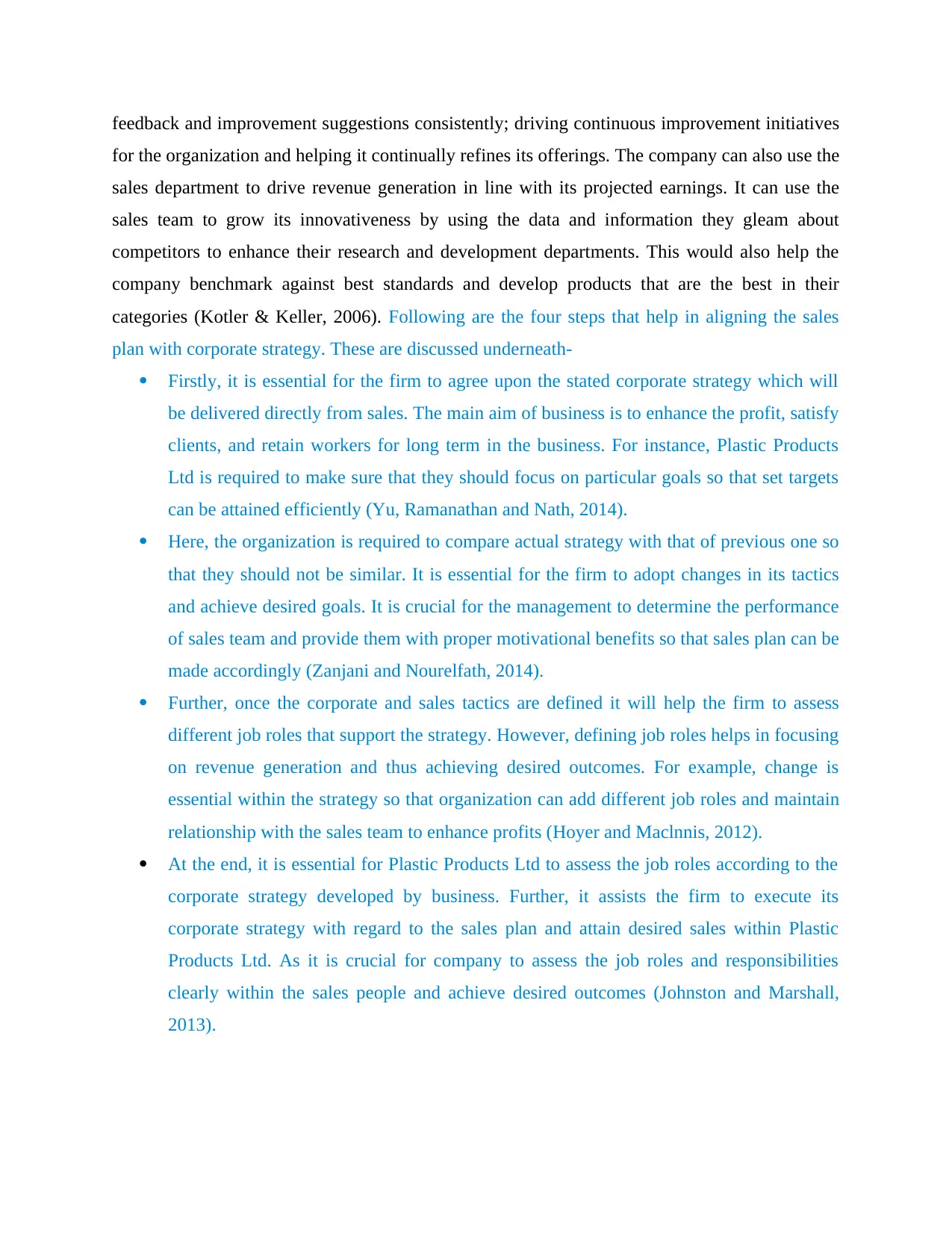
feedback and improvement suggestions consistently; driving continuous improvement initiatives
for the organization and helping it continually refines its offerings. The company can also use the
sales department to drive revenue generation in line with its projected earnings. It can use the
sales team to grow its innovativeness by using the data and information they gleam about
competitors to enhance their research and development departments. This would also help the
company benchmark against best standards and develop products that are the best in their
categories (Kotler & Keller, 2006). Following are the four steps that help in aligning the sales
plan with corporate strategy. These are discussed underneath-
Firstly, it is essential for the firm to agree upon the stated corporate strategy which will
be delivered directly from sales. The main aim of business is to enhance the profit, satisfy
clients, and retain workers for long term in the business. For instance, Plastic Products
Ltd is required to make sure that they should focus on particular goals so that set targets
can be attained efficiently (Yu, Ramanathan and Nath, 2014).
Here, the organization is required to compare actual strategy with that of previous one so
that they should not be similar. It is essential for the firm to adopt changes in its tactics
and achieve desired goals. It is crucial for the management to determine the performance
of sales team and provide them with proper motivational benefits so that sales plan can be
made accordingly (Zanjani and Nourelfath, 2014).
Further, once the corporate and sales tactics are defined it will help the firm to assess
different job roles that support the strategy. However, defining job roles helps in focusing
on revenue generation and thus achieving desired outcomes. For example, change is
essential within the strategy so that organization can add different job roles and maintain
relationship with the sales team to enhance profits (Hoyer and Maclnnis, 2012).
At the end, it is essential for Plastic Products Ltd to assess the job roles according to the
corporate strategy developed by business. Further, it assists the firm to execute its
corporate strategy with regard to the sales plan and attain desired sales within Plastic
Products Ltd. As it is crucial for company to assess the job roles and responsibilities
clearly within the sales people and achieve desired outcomes (Johnston and Marshall,
2013).
for the organization and helping it continually refines its offerings. The company can also use the
sales department to drive revenue generation in line with its projected earnings. It can use the
sales team to grow its innovativeness by using the data and information they gleam about
competitors to enhance their research and development departments. This would also help the
company benchmark against best standards and develop products that are the best in their
categories (Kotler & Keller, 2006). Following are the four steps that help in aligning the sales
plan with corporate strategy. These are discussed underneath-
Firstly, it is essential for the firm to agree upon the stated corporate strategy which will
be delivered directly from sales. The main aim of business is to enhance the profit, satisfy
clients, and retain workers for long term in the business. For instance, Plastic Products
Ltd is required to make sure that they should focus on particular goals so that set targets
can be attained efficiently (Yu, Ramanathan and Nath, 2014).
Here, the organization is required to compare actual strategy with that of previous one so
that they should not be similar. It is essential for the firm to adopt changes in its tactics
and achieve desired goals. It is crucial for the management to determine the performance
of sales team and provide them with proper motivational benefits so that sales plan can be
made accordingly (Zanjani and Nourelfath, 2014).
Further, once the corporate and sales tactics are defined it will help the firm to assess
different job roles that support the strategy. However, defining job roles helps in focusing
on revenue generation and thus achieving desired outcomes. For example, change is
essential within the strategy so that organization can add different job roles and maintain
relationship with the sales team to enhance profits (Hoyer and Maclnnis, 2012).
At the end, it is essential for Plastic Products Ltd to assess the job roles according to the
corporate strategy developed by business. Further, it assists the firm to execute its
corporate strategy with regard to the sales plan and attain desired sales within Plastic
Products Ltd. As it is crucial for company to assess the job roles and responsibilities
clearly within the sales people and achieve desired outcomes (Johnston and Marshall,
2013).
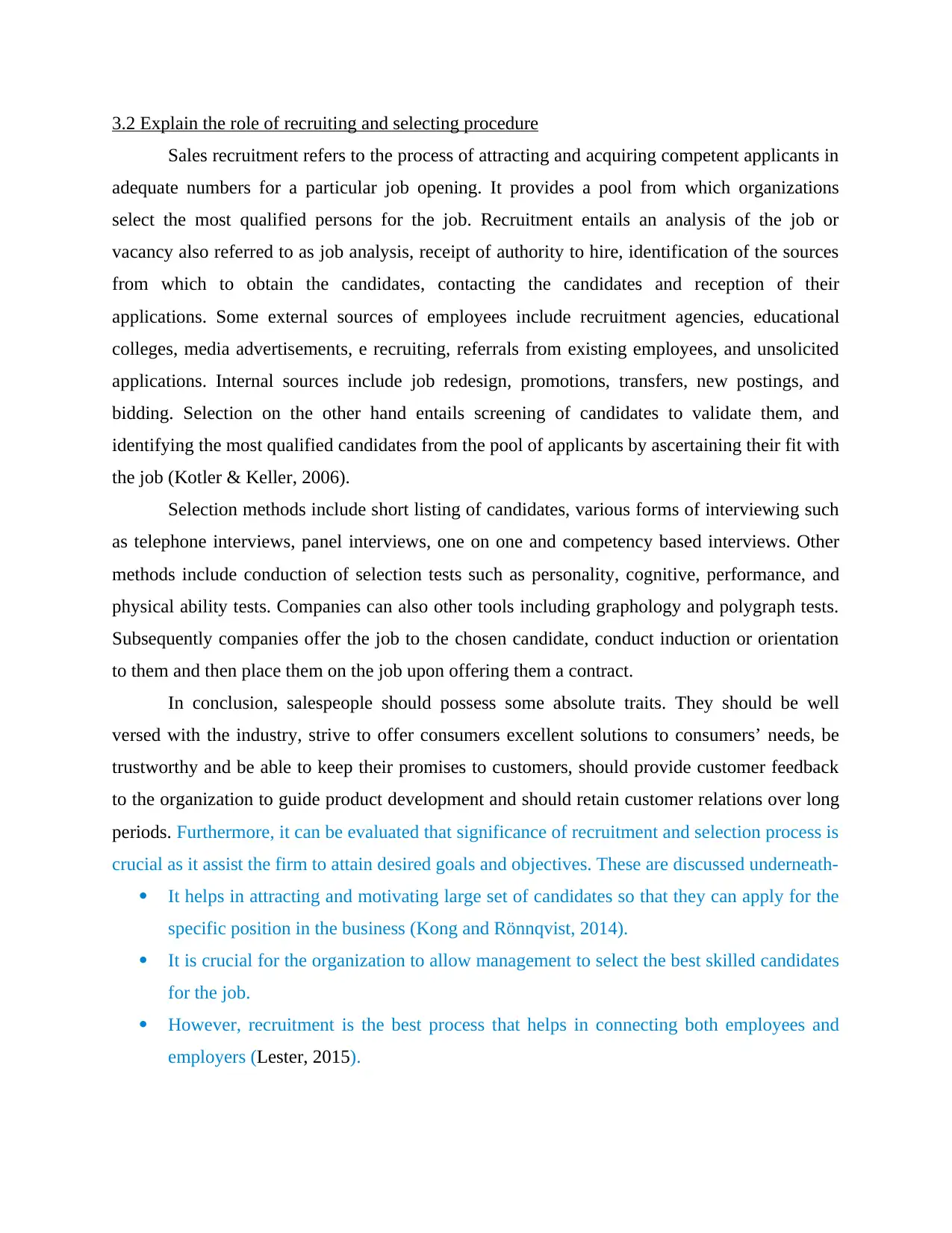
3.2 Explain the role of recruiting and selecting procedure
Sales recruitment refers to the process of attracting and acquiring competent applicants in
adequate numbers for a particular job opening. It provides a pool from which organizations
select the most qualified persons for the job. Recruitment entails an analysis of the job or
vacancy also referred to as job analysis, receipt of authority to hire, identification of the sources
from which to obtain the candidates, contacting the candidates and reception of their
applications. Some external sources of employees include recruitment agencies, educational
colleges, media advertisements, e recruiting, referrals from existing employees, and unsolicited
applications. Internal sources include job redesign, promotions, transfers, new postings, and
bidding. Selection on the other hand entails screening of candidates to validate them, and
identifying the most qualified candidates from the pool of applicants by ascertaining their fit with
the job (Kotler & Keller, 2006).
Selection methods include short listing of candidates, various forms of interviewing such
as telephone interviews, panel interviews, one on one and competency based interviews. Other
methods include conduction of selection tests such as personality, cognitive, performance, and
physical ability tests. Companies can also other tools including graphology and polygraph tests.
Subsequently companies offer the job to the chosen candidate, conduct induction or orientation
to them and then place them on the job upon offering them a contract.
In conclusion, salespeople should possess some absolute traits. They should be well
versed with the industry, strive to offer consumers excellent solutions to consumers’ needs, be
trustworthy and be able to keep their promises to customers, should provide customer feedback
to the organization to guide product development and should retain customer relations over long
periods. Furthermore, it can be evaluated that significance of recruitment and selection process is
crucial as it assist the firm to attain desired goals and objectives. These are discussed underneath-
It helps in attracting and motivating large set of candidates so that they can apply for the
specific position in the business (Kong and Rönnqvist, 2014).
It is crucial for the organization to allow management to select the best skilled candidates
for the job.
However, recruitment is the best process that helps in connecting both employees and
employers (Lester, 2015).
Sales recruitment refers to the process of attracting and acquiring competent applicants in
adequate numbers for a particular job opening. It provides a pool from which organizations
select the most qualified persons for the job. Recruitment entails an analysis of the job or
vacancy also referred to as job analysis, receipt of authority to hire, identification of the sources
from which to obtain the candidates, contacting the candidates and reception of their
applications. Some external sources of employees include recruitment agencies, educational
colleges, media advertisements, e recruiting, referrals from existing employees, and unsolicited
applications. Internal sources include job redesign, promotions, transfers, new postings, and
bidding. Selection on the other hand entails screening of candidates to validate them, and
identifying the most qualified candidates from the pool of applicants by ascertaining their fit with
the job (Kotler & Keller, 2006).
Selection methods include short listing of candidates, various forms of interviewing such
as telephone interviews, panel interviews, one on one and competency based interviews. Other
methods include conduction of selection tests such as personality, cognitive, performance, and
physical ability tests. Companies can also other tools including graphology and polygraph tests.
Subsequently companies offer the job to the chosen candidate, conduct induction or orientation
to them and then place them on the job upon offering them a contract.
In conclusion, salespeople should possess some absolute traits. They should be well
versed with the industry, strive to offer consumers excellent solutions to consumers’ needs, be
trustworthy and be able to keep their promises to customers, should provide customer feedback
to the organization to guide product development and should retain customer relations over long
periods. Furthermore, it can be evaluated that significance of recruitment and selection process is
crucial as it assist the firm to attain desired goals and objectives. These are discussed underneath-
It helps in attracting and motivating large set of candidates so that they can apply for the
specific position in the business (Kong and Rönnqvist, 2014).
It is crucial for the organization to allow management to select the best skilled candidates
for the job.
However, recruitment is the best process that helps in connecting both employees and
employers (Lester, 2015).
⊘ This is a preview!⊘
Do you want full access?
Subscribe today to unlock all pages.

Trusted by 1+ million students worldwide
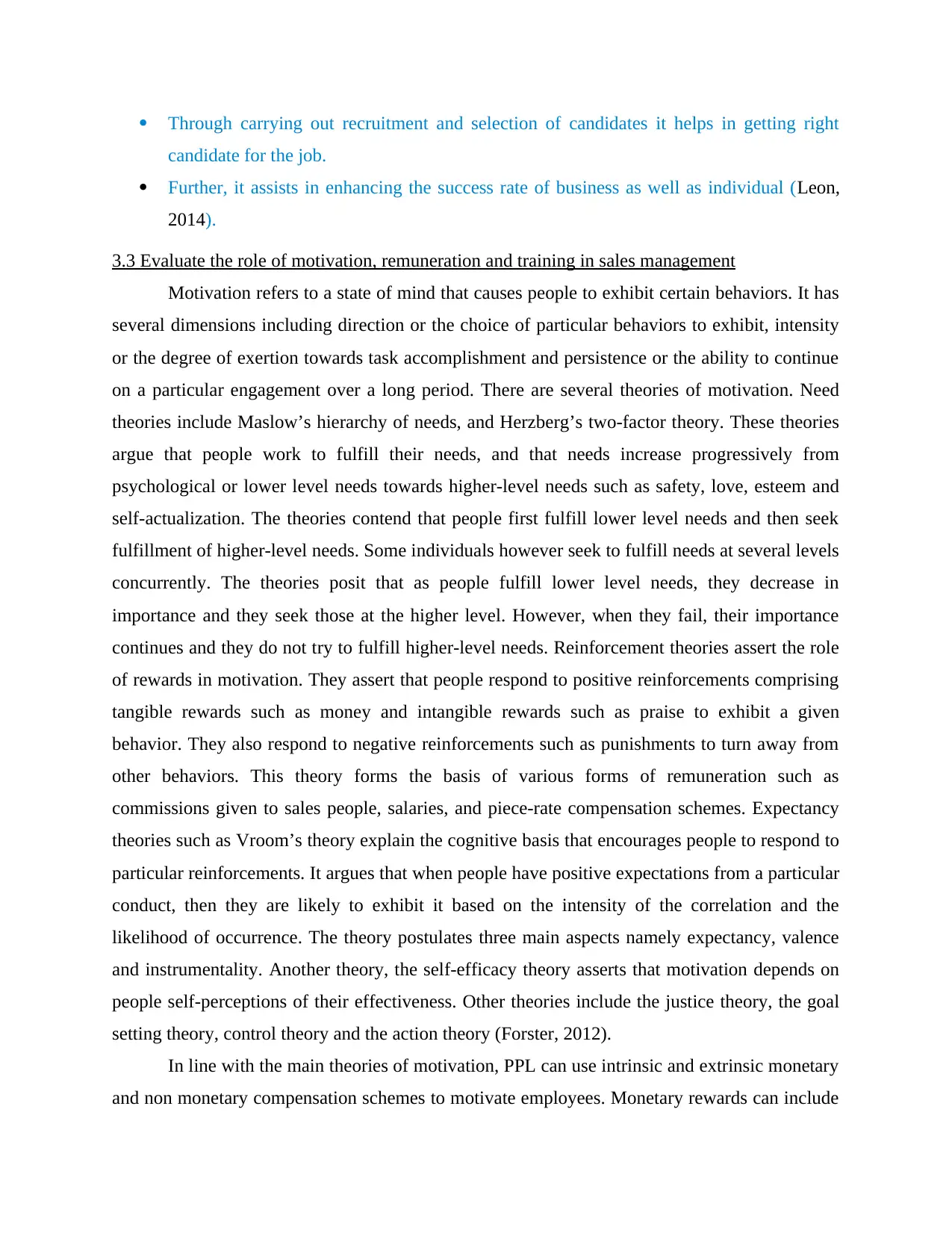
Through carrying out recruitment and selection of candidates it helps in getting right
candidate for the job.
Further, it assists in enhancing the success rate of business as well as individual (Leon,
2014).
3.3 Evaluate the role of motivation, remuneration and training in sales management
Motivation refers to a state of mind that causes people to exhibit certain behaviors. It has
several dimensions including direction or the choice of particular behaviors to exhibit, intensity
or the degree of exertion towards task accomplishment and persistence or the ability to continue
on a particular engagement over a long period. There are several theories of motivation. Need
theories include Maslow’s hierarchy of needs, and Herzberg’s two-factor theory. These theories
argue that people work to fulfill their needs, and that needs increase progressively from
psychological or lower level needs towards higher-level needs such as safety, love, esteem and
self-actualization. The theories contend that people first fulfill lower level needs and then seek
fulfillment of higher-level needs. Some individuals however seek to fulfill needs at several levels
concurrently. The theories posit that as people fulfill lower level needs, they decrease in
importance and they seek those at the higher level. However, when they fail, their importance
continues and they do not try to fulfill higher-level needs. Reinforcement theories assert the role
of rewards in motivation. They assert that people respond to positive reinforcements comprising
tangible rewards such as money and intangible rewards such as praise to exhibit a given
behavior. They also respond to negative reinforcements such as punishments to turn away from
other behaviors. This theory forms the basis of various forms of remuneration such as
commissions given to sales people, salaries, and piece-rate compensation schemes. Expectancy
theories such as Vroom’s theory explain the cognitive basis that encourages people to respond to
particular reinforcements. It argues that when people have positive expectations from a particular
conduct, then they are likely to exhibit it based on the intensity of the correlation and the
likelihood of occurrence. The theory postulates three main aspects namely expectancy, valence
and instrumentality. Another theory, the self-efficacy theory asserts that motivation depends on
people self-perceptions of their effectiveness. Other theories include the justice theory, the goal
setting theory, control theory and the action theory (Forster, 2012).
In line with the main theories of motivation, PPL can use intrinsic and extrinsic monetary
and non monetary compensation schemes to motivate employees. Monetary rewards can include
candidate for the job.
Further, it assists in enhancing the success rate of business as well as individual (Leon,
2014).
3.3 Evaluate the role of motivation, remuneration and training in sales management
Motivation refers to a state of mind that causes people to exhibit certain behaviors. It has
several dimensions including direction or the choice of particular behaviors to exhibit, intensity
or the degree of exertion towards task accomplishment and persistence or the ability to continue
on a particular engagement over a long period. There are several theories of motivation. Need
theories include Maslow’s hierarchy of needs, and Herzberg’s two-factor theory. These theories
argue that people work to fulfill their needs, and that needs increase progressively from
psychological or lower level needs towards higher-level needs such as safety, love, esteem and
self-actualization. The theories contend that people first fulfill lower level needs and then seek
fulfillment of higher-level needs. Some individuals however seek to fulfill needs at several levels
concurrently. The theories posit that as people fulfill lower level needs, they decrease in
importance and they seek those at the higher level. However, when they fail, their importance
continues and they do not try to fulfill higher-level needs. Reinforcement theories assert the role
of rewards in motivation. They assert that people respond to positive reinforcements comprising
tangible rewards such as money and intangible rewards such as praise to exhibit a given
behavior. They also respond to negative reinforcements such as punishments to turn away from
other behaviors. This theory forms the basis of various forms of remuneration such as
commissions given to sales people, salaries, and piece-rate compensation schemes. Expectancy
theories such as Vroom’s theory explain the cognitive basis that encourages people to respond to
particular reinforcements. It argues that when people have positive expectations from a particular
conduct, then they are likely to exhibit it based on the intensity of the correlation and the
likelihood of occurrence. The theory postulates three main aspects namely expectancy, valence
and instrumentality. Another theory, the self-efficacy theory asserts that motivation depends on
people self-perceptions of their effectiveness. Other theories include the justice theory, the goal
setting theory, control theory and the action theory (Forster, 2012).
In line with the main theories of motivation, PPL can use intrinsic and extrinsic monetary
and non monetary compensation schemes to motivate employees. Monetary rewards can include
Paraphrase This Document
Need a fresh take? Get an instant paraphrase of this document with our AI Paraphraser
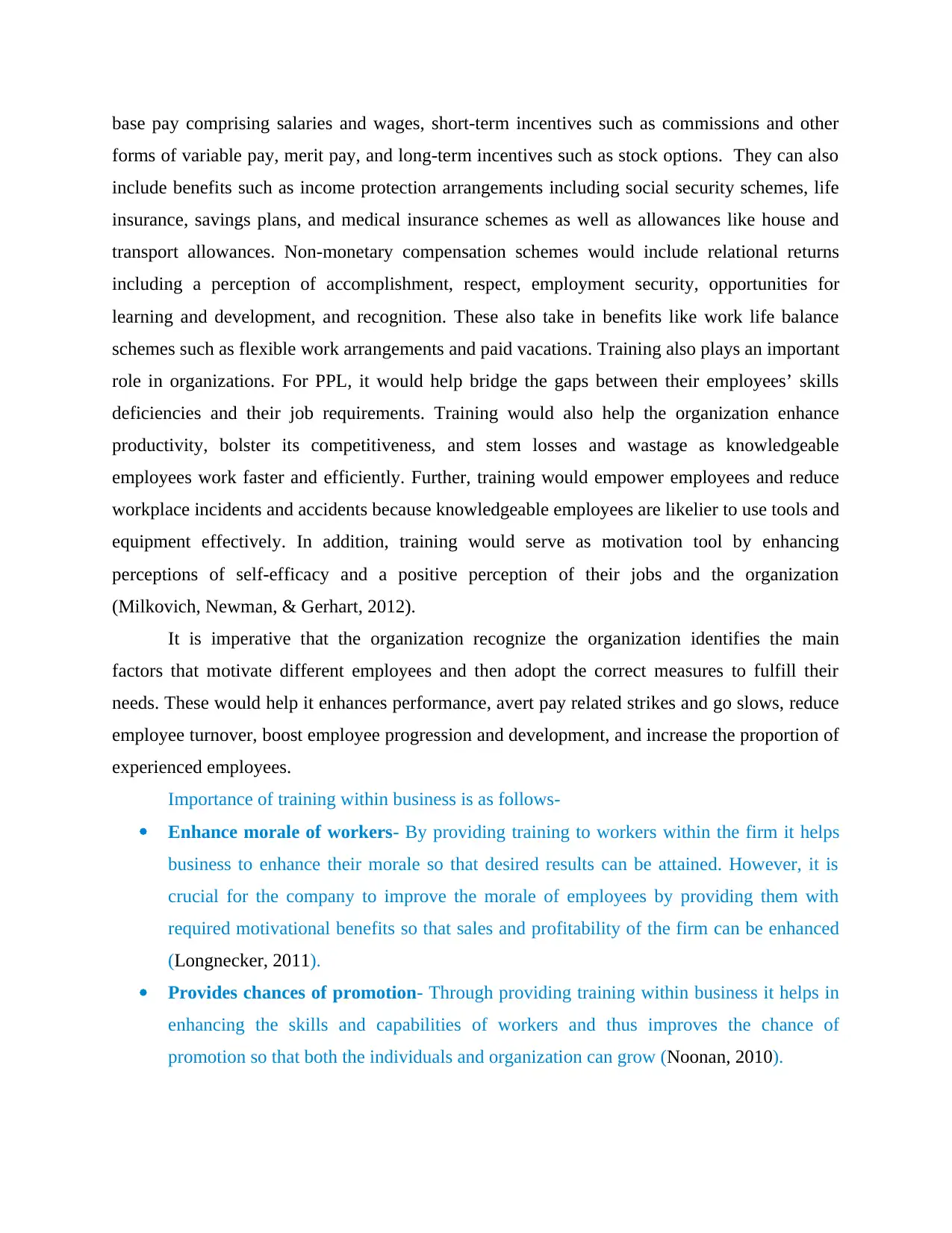
base pay comprising salaries and wages, short-term incentives such as commissions and other
forms of variable pay, merit pay, and long-term incentives such as stock options. They can also
include benefits such as income protection arrangements including social security schemes, life
insurance, savings plans, and medical insurance schemes as well as allowances like house and
transport allowances. Non-monetary compensation schemes would include relational returns
including a perception of accomplishment, respect, employment security, opportunities for
learning and development, and recognition. These also take in benefits like work life balance
schemes such as flexible work arrangements and paid vacations. Training also plays an important
role in organizations. For PPL, it would help bridge the gaps between their employees’ skills
deficiencies and their job requirements. Training would also help the organization enhance
productivity, bolster its competitiveness, and stem losses and wastage as knowledgeable
employees work faster and efficiently. Further, training would empower employees and reduce
workplace incidents and accidents because knowledgeable employees are likelier to use tools and
equipment effectively. In addition, training would serve as motivation tool by enhancing
perceptions of self-efficacy and a positive perception of their jobs and the organization
(Milkovich, Newman, & Gerhart, 2012).
It is imperative that the organization recognize the organization identifies the main
factors that motivate different employees and then adopt the correct measures to fulfill their
needs. These would help it enhances performance, avert pay related strikes and go slows, reduce
employee turnover, boost employee progression and development, and increase the proportion of
experienced employees.
Importance of training within business is as follows-
Enhance morale of workers- By providing training to workers within the firm it helps
business to enhance their morale so that desired results can be attained. However, it is
crucial for the company to improve the morale of employees by providing them with
required motivational benefits so that sales and profitability of the firm can be enhanced
(Longnecker, 2011).
Provides chances of promotion- Through providing training within business it helps in
enhancing the skills and capabilities of workers and thus improves the chance of
promotion so that both the individuals and organization can grow (Noonan, 2010).
forms of variable pay, merit pay, and long-term incentives such as stock options. They can also
include benefits such as income protection arrangements including social security schemes, life
insurance, savings plans, and medical insurance schemes as well as allowances like house and
transport allowances. Non-monetary compensation schemes would include relational returns
including a perception of accomplishment, respect, employment security, opportunities for
learning and development, and recognition. These also take in benefits like work life balance
schemes such as flexible work arrangements and paid vacations. Training also plays an important
role in organizations. For PPL, it would help bridge the gaps between their employees’ skills
deficiencies and their job requirements. Training would also help the organization enhance
productivity, bolster its competitiveness, and stem losses and wastage as knowledgeable
employees work faster and efficiently. Further, training would empower employees and reduce
workplace incidents and accidents because knowledgeable employees are likelier to use tools and
equipment effectively. In addition, training would serve as motivation tool by enhancing
perceptions of self-efficacy and a positive perception of their jobs and the organization
(Milkovich, Newman, & Gerhart, 2012).
It is imperative that the organization recognize the organization identifies the main
factors that motivate different employees and then adopt the correct measures to fulfill their
needs. These would help it enhances performance, avert pay related strikes and go slows, reduce
employee turnover, boost employee progression and development, and increase the proportion of
experienced employees.
Importance of training within business is as follows-
Enhance morale of workers- By providing training to workers within the firm it helps
business to enhance their morale so that desired results can be attained. However, it is
crucial for the company to improve the morale of employees by providing them with
required motivational benefits so that sales and profitability of the firm can be enhanced
(Longnecker, 2011).
Provides chances of promotion- Through providing training within business it helps in
enhancing the skills and capabilities of workers and thus improves the chance of
promotion so that both the individuals and organization can grow (Noonan, 2010).
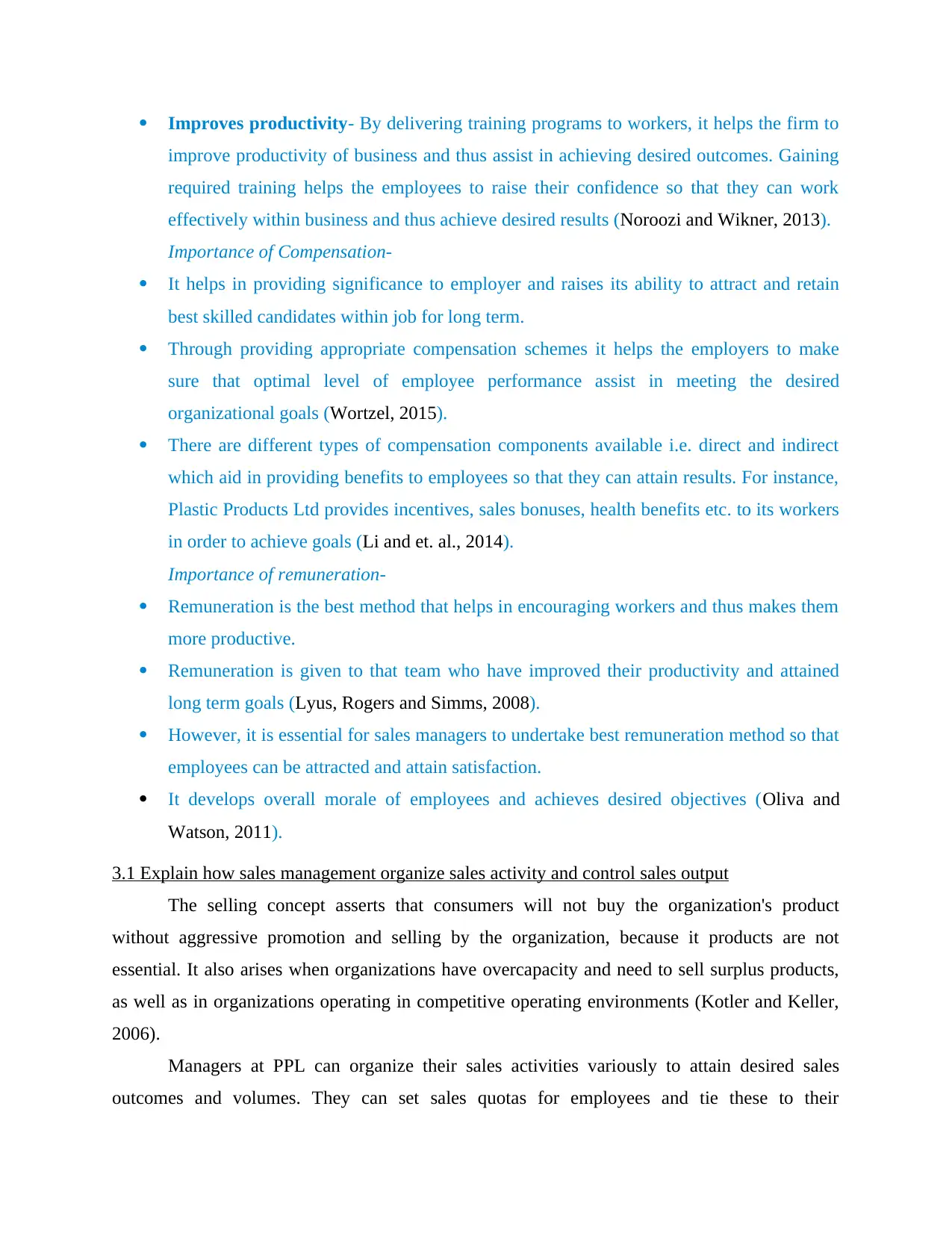
Improves productivity- By delivering training programs to workers, it helps the firm to
improve productivity of business and thus assist in achieving desired outcomes. Gaining
required training helps the employees to raise their confidence so that they can work
effectively within business and thus achieve desired results (Noroozi and Wikner, 2013).
Importance of Compensation-
It helps in providing significance to employer and raises its ability to attract and retain
best skilled candidates within job for long term.
Through providing appropriate compensation schemes it helps the employers to make
sure that optimal level of employee performance assist in meeting the desired
organizational goals (Wortzel, 2015).
There are different types of compensation components available i.e. direct and indirect
which aid in providing benefits to employees so that they can attain results. For instance,
Plastic Products Ltd provides incentives, sales bonuses, health benefits etc. to its workers
in order to achieve goals (Li and et. al., 2014).
Importance of remuneration-
Remuneration is the best method that helps in encouraging workers and thus makes them
more productive.
Remuneration is given to that team who have improved their productivity and attained
long term goals (Lyus, Rogers and Simms, 2008).
However, it is essential for sales managers to undertake best remuneration method so that
employees can be attracted and attain satisfaction.
It develops overall morale of employees and achieves desired objectives (Oliva and
Watson, 2011).
3.1 Explain how sales management organize sales activity and control sales output
The selling concept asserts that consumers will not buy the organization's product
without aggressive promotion and selling by the organization, because it products are not
essential. It also arises when organizations have overcapacity and need to sell surplus products,
as well as in organizations operating in competitive operating environments (Kotler and Keller,
2006).
Managers at PPL can organize their sales activities variously to attain desired sales
outcomes and volumes. They can set sales quotas for employees and tie these to their
improve productivity of business and thus assist in achieving desired outcomes. Gaining
required training helps the employees to raise their confidence so that they can work
effectively within business and thus achieve desired results (Noroozi and Wikner, 2013).
Importance of Compensation-
It helps in providing significance to employer and raises its ability to attract and retain
best skilled candidates within job for long term.
Through providing appropriate compensation schemes it helps the employers to make
sure that optimal level of employee performance assist in meeting the desired
organizational goals (Wortzel, 2015).
There are different types of compensation components available i.e. direct and indirect
which aid in providing benefits to employees so that they can attain results. For instance,
Plastic Products Ltd provides incentives, sales bonuses, health benefits etc. to its workers
in order to achieve goals (Li and et. al., 2014).
Importance of remuneration-
Remuneration is the best method that helps in encouraging workers and thus makes them
more productive.
Remuneration is given to that team who have improved their productivity and attained
long term goals (Lyus, Rogers and Simms, 2008).
However, it is essential for sales managers to undertake best remuneration method so that
employees can be attracted and attain satisfaction.
It develops overall morale of employees and achieves desired objectives (Oliva and
Watson, 2011).
3.1 Explain how sales management organize sales activity and control sales output
The selling concept asserts that consumers will not buy the organization's product
without aggressive promotion and selling by the organization, because it products are not
essential. It also arises when organizations have overcapacity and need to sell surplus products,
as well as in organizations operating in competitive operating environments (Kotler and Keller,
2006).
Managers at PPL can organize their sales activities variously to attain desired sales
outcomes and volumes. They can set sales quotas for employees and tie these to their
⊘ This is a preview!⊘
Do you want full access?
Subscribe today to unlock all pages.

Trusted by 1+ million students worldwide
1 out of 21
Related Documents
Your All-in-One AI-Powered Toolkit for Academic Success.
+13062052269
info@desklib.com
Available 24*7 on WhatsApp / Email
![[object Object]](/_next/static/media/star-bottom.7253800d.svg)
Unlock your academic potential
Copyright © 2020–2025 A2Z Services. All Rights Reserved. Developed and managed by ZUCOL.





